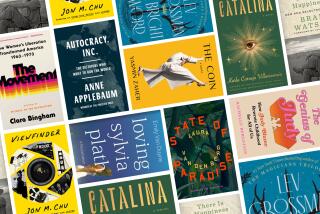THE RISE AND FALL OF THE GREAT...
- Share via
THE RISE AND FALL OF THE GREAT POWERS Economic Change and Military Conflict From 1500 to 2000 by Paul Kennedy (Vintage Books: $12.95, maps and charts)
This best-selling work of history examines the rise and fall of world powers during the last five centuries, from the time of the Ming Dynasty in China to the present.
According to Paul Kennedy, the lessons of history have particular application for the great powers of today, especially those forced to underwrite the cost of empire. Japan, whose military is subsidized by the United States, is reaching record economic growth. China’s “green revolution” is dealing well with its food supply needs.
The European Economic Community (EEC), on the other hand, suffers under the weight of its defense spending. The Soviet Union spends too much on the military, Kennedy argues, at the expense of its agricultural and industrial needs. The United States runs the risk of “imperial overstretch.”
According to Times reviewer Alfred Gollin, Kennedy’s is “a powerful, brilliant and well-informed analysis of the five great powers of the world that today compete for the future of our planet.”
THE DAY I BECAME AN AUTODIDACT And the Advice, Adventures and Acrimonies That Befell Me Thereafter by Kendall Hailey (Delta: $8.95)
Kendall Hailey’s first battle with formal education occurred at age 5: She had drawn “a true rendering” of her Uncle Thomas’ wheelchair, but her teacher said it was too depressing because it was all gray; wouldn’t she like to add a touch of yellow? But it was not until the 10th grade, when she received her school’s summer reading list, that she resolved to follow the example set by Jessica Mitford: to become an autodidact.
Kendall’s parents (playwright Oliver Hailey and novelist Elizabeth Forsythe Hailey) encouraged her, telling her to take 10 years to educate herself--and then to write about it.
“The Day I Became an Autodidact” is the record of her self-tutoring; her exploration of the classics, from Virgil’s “Aeneid” to Tolstoy’s “Anna Karenina,” intermingled with the ordinary contemplation of the dailiness of a young girl’s life. An engaging work.
CORRUPTIONS OF EMPIRE Life Studies & the Reagan Era by Alexander Cockburn (Verso: $13.95)
This anthology collects the iconoclastic and combative writings of Alexander Cockburn, best-known for his columns in the Nation and the Village Voice, from his arrival in the United States in June, 1972, (“the month Nixon’s burglars broke into the Watergate”) through 1987 (“as Col. North lectured Congress about the role of executive power in the Iran-Contra scandal”).
Cockburn writes unabashedly from the left, and he invariably draws blood, but not all the pieces here are political. Some provide details about his personal background: His father, Claud Cockburn, was a noted English Communist journalist.
But Cockburn is particularly pleased to relay news about his ancestor, Adm. Sir George Cockburn, whose raiding party torched the White House during the War of 1812. Sir George’s descendant, generations later, seems to have inherited the same instinct--and his aim is just as true.
JULIA PARADISE A Novel by Rod Jones (King Penguin: $6.95)
“Julia Paradise” is the story of Kenneth Ayres, a Scottish psychiatrist living in Shanghai in 1927 whose practice is made up of the wives and daughters of British colonials. A former student of Freud’s, Ayres has maintained a lifelong passion for the character of Wendy in the play, “Peter Pan”--an obsession that he indulges by hiring Chinese prostitutes barely out of childhood.
When the Rev. William Paradise asks Ayres to take his wife as a patient, Ayres initially suggests that “in the end the cure (is) sometimes as simple as a steamship ticket home.” But he grows fascinated with Julia’s hallucinations, her re-creation of her childhood, her outright lies. He even begins to believe her.
Set against the background of China in the 1930s, “Julia Paradise” is also the story of that nation’s revolution against the Western colonials and missionaries.
AIDS: Cultural Analysis, Cultural Activism edited by Douglas Crimp (An OCTOBER Book / The MIT Press: $20, cloth; $10.95, paper; illustrated)
This collection of 14 essays first appeared as the winter, 1987, edition of “October,” a journal of art theory, criticism and politics. Editor Douglas Crimp cites collective endeavors by artists in major metropolitan centers to document the realities of AIDS, as the government and even the media have refused to do.
In the essay, “AIDS: Keywords,” Jan Zita Grover points out how the very language with which AIDS is discussed is often inaccurate as well as implicitly fatalistic. AIDS (Acquired Immune Deficiency Syndrome) is a syndrome , a set of symptoms, not a disease . The term victim , Grover continues, is commonly applied to people with AIDS: “Victims always end up revealing some tragic character flaw that has invited their tragedy.”
In another essay, a man who has lived with AIDS for 2 1/2 years responds to the pervasive sense of hopelessness: “Reinforcement of hopelessness . . . causes despair, and I believe that despair kills people with AIDS as much as any of AIDS’ physical manifestations.”
Most disturbing is the article by Paula A. Treichler, revealing the truth about the American medical Establishment’s response to the AIDS crisis.
More to Read
Sign up for our Book Club newsletter
Get the latest news, events and more from the Los Angeles Times Book Club, and help us get L.A. reading and talking.
You may occasionally receive promotional content from the Los Angeles Times.







